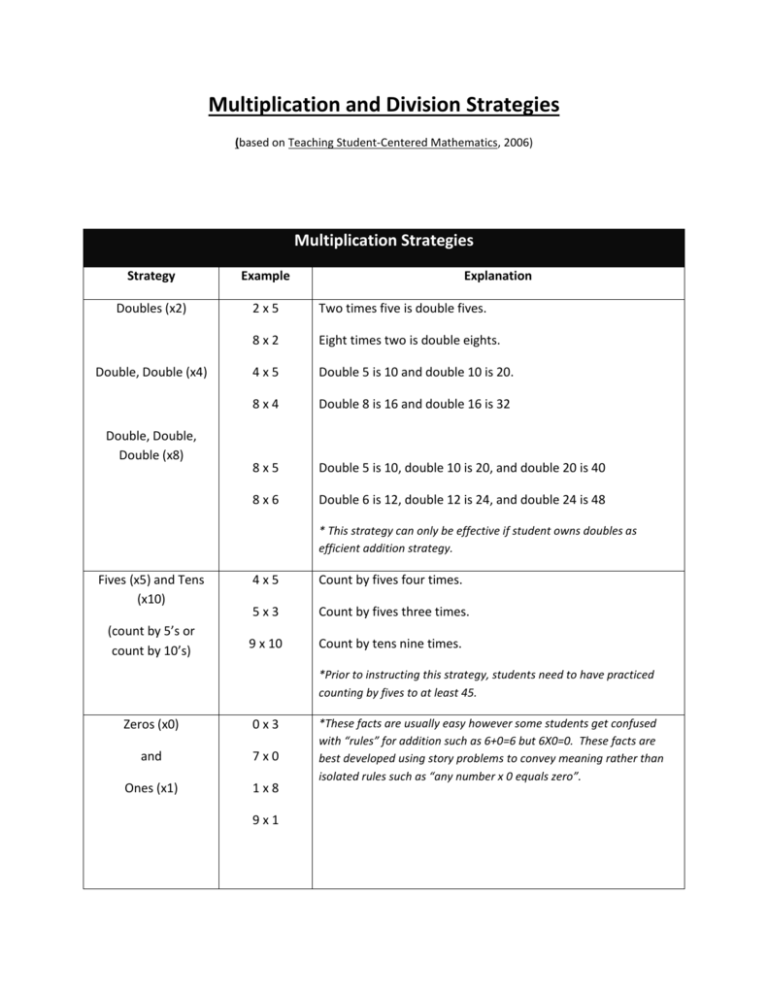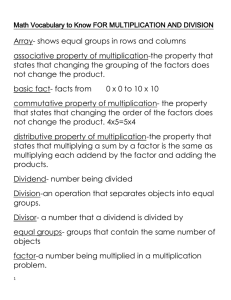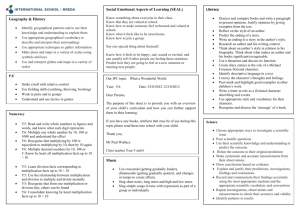Multiplication and Division Strategies
advertisement

Multiplication and Division Strategies (based on Teaching Student-Centered Mathematics, 2006) Multiplication Strategies Strategy Example Doubles (x2) 2x5 Two times five is double fives. 8x2 Eight times two is double eights. 4x5 Double 5 is 10 and double 10 is 20. 8x4 Double 8 is 16 and double 16 is 32 8x5 Double 5 is 10, double 10 is 20, and double 20 is 40 8x6 Double 6 is 12, double 12 is 24, and double 24 is 48 Double, Double (x4) Double, Double, Double (x8) Explanation * This strategy can only be effective if student owns doubles as efficient addition strategy. Fives (x5) and Tens (x10) (count by 5’s or count by 10’s) 4x5 Count by fives four times. 5x3 Count by fives three times. 9 x 10 Count by tens nine times. *Prior to instructing this strategy, students need to have practiced counting by fives to at least 45. Zeros (x0) 0x3 and 7x0 Ones (x1) 1x8 9x1 *These facts are usually easy however some students get confused with “rules” for addition such as 6+0=6 but 6X0=0. These facts are best developed using story problems to convey meaning rather than isolated rules such as “any number x 0 equals zero”. Multiplication Strategies Strategy Example Helping Facts 3x8 (x3) Explanation Relate the fact to a known fact. Three times eight is double eights and eight more. (x6) (x7) 6x7 Nifty Nines Fives times seven is thirty-five and add another seven to make forty-two. Or seven times seven is forty-nine and take away a seven to make forty-two. Through investigation of patterns, (x9) 4x9 9x8 1. The tens digit of the product is one less than the “other” factor (4x9=36) 2. The sum of the two digits in the product is always nine. (9x8=72… 7+2=9) More Strategies by Factor Any number times ZERO is ZERO Ex: 0 x 6 = 0 12 x 0 = 0 Zero Property Any number times ONE is that number. Ex: 1 x 4 = 4 23 x 1 = 23 Identity Property Any number that is multiplied by TWO just gets doubled. Ex: 2 x 6 = 12 6 + 6 = 12 When multiplying by THREE, you can multiply that number by 2 and add the factor to the product. Ex: 4 x 3 = 12 (4 x 2) + (4 x 1) 8 + 4 = 12 When multiplying by FOUR double the factor and then double it again. Ex: 5 x 4 = 20 5 + 5 = 10 and 10 + 10 = 20 When multiplying by FIVE, you can skip count by 5’s Ex: 6 x 5 = 30 (5, 10, 15, 20, 25, 30) When multiplying by SIX, you can multiply that factor by 5 and add that factor to the product Ex: 7 x 6 = 42 (7 x 5) + (7 x 1) 35 + 7 = 42 When multiplying a number by SEVEN, you can multiply the factor by FIVE and add a double. Ex: 8 x 7 = 42 (8 x 5) + (8 x 2) 40 + 16 = 56 When multiplying by EIGHT, you can skip count by 10’s and subtract a double. Ex: 9 x 8 = 72 (10, 20, 30, 40, 50, 60, 70, 80, 90) 90 – (9x2) 90 – 18 = 72 When multiplying a single digit times a NINE, skip count by 10’s and subtract the factor. Ex: 6 x 9 = 54 (6 x 10) – (6 x 1) 60 - 6 = 54 When multiplying any number times TEN, skip count by 10 or just add a zero onto the end of the factor. Ex: 5 x 10 = 50 (10, 20, 30, 40, 50) or 34 x 10 = 340 Mastery of multiplication facts and connections between multiplication and division are the key elements of division fact mastery. Do not introduce premature drill and practice of division facts until students have mastered and own efficient strategies for related multiplication facts. Counting on fingers or making marks on paper can never result in quick fact recall regardless of the amount of drill. Drill without an efficient strategy present offers no benefit to students and merely reinforces inefficient practices. Division Strategies Strategy Example Division as ThinkMultiplication 42 ÷ 6 Explanation Six times what makes forty-two? *If students have trouble with this strategy, it is best to work on the related multiplication facts and developing efficient multiplication strategies. Drill and practice of division facts without efficient strategies for related multiplication facts is ineffective.








